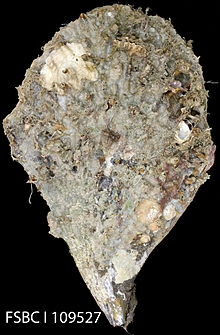Atrina rigida
| Atrina rigida | |
|---|---|
 |
|
| Scientific classification | |
| Kingdom: | Animalia |
| Phylum: | Mollusca |
| Class: | Bivalvia |
| Order: | Pterioida |
| Family: | Pinnidae |
| Genus: | Atrina |
| Species: | A. rigida |
| Binomial name | |
|
Atrina rigida (Lightfoot, 1786) |
|
| Synonyms | |
|
Pinna rigida |
|
Pinna rigida
Atrina rigida, commonly known as the rigid pen shell, is a bivalve mollusc found from the North Carolina coast through the West Indies and to Brazil. It has attracted research interest in studies of calcification in its nacre as well as other aspects of its ecology.
As is typical with the Pinnidae, the shell is elongated and wedge-shaped, coming to a point at the anterior end. There are fifteen or more ridges running lengthwise, and spines arise from these towards the posterior edge. The exterior of the shell is an olive brown. The interior is nacreous to about half its length, and there is a conspicuous scar in the center of the shell at the border of this area, where the posterior adductor is attached. The mantle of the animal is orange and does not fill the shell entirely. The similar A. seminuda has the adductor scar entirely within the nacreous area.
A. rigida may grow to 30 centimeters in length, though typical specimens are somewhat shorter. it also produces perfect black pearl but after 20 years they can produce the pearl as natural.
Like most pen shells, A. rigida lives in soft bottoms, with the majority of the shell buried, point down, leaving only a few inches exposed, held in place by an extensive net of byssal threads. This pen shell tends to prefer shallower waters, whereas related species prefer greater depths.
It is a suspension feeder, taking in water and nourishment through the gap between the valves at the posterior (upper) edge. Commensal crustaceans may live in this opening, apparently feeding upon excess food; barnacles and other creatures may attach themselves to the exposed exterior of the shells.
This species is preyed upon by starfish, and other carnivorous gastropods, including the horse conch Pleuroploca gigantea.
A. rigida is noted for its ability to heal breaks and holes made in its shell.
...
Wikipedia
